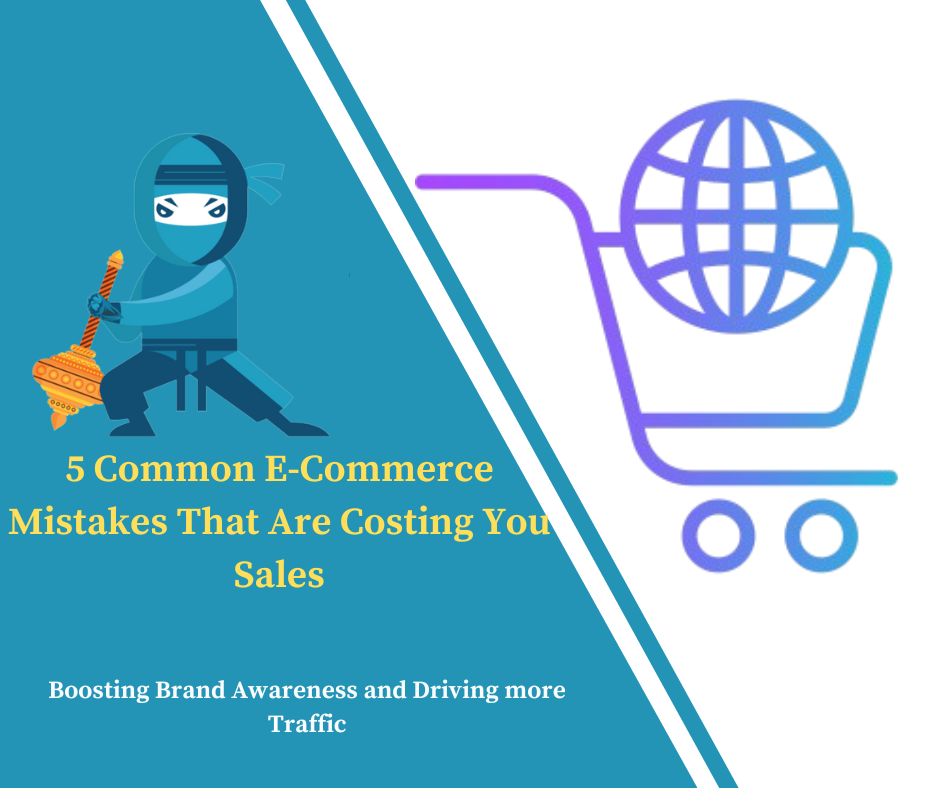5 Common E-Commerce Mistakes That Are Costing You Sales
E-commerce has opened a world of opportunities for businesses, enabling them to reach customers globally, operate 24/7, and provide a seamless shopping experience. However, despite the booming potential, many e-commerce businesses struggle to convert visitors into paying customers. Why? Several common mistakes in the setup and management of e-commerce stores are often to blame. In this article, we’ll explore five common e-com
1. Lack of Mobile Optimization
Mobile commerce (or m-commerce) is growing exponentially, with over half of e-commerce traffic coming from mobile devices. If your e-commerce website isn’t optimized for mobile users, you are alienating a large portion of potential buyers. A poorly designed mobile site will frustrate users with slow loading times, difficult navigation, and unreadable text, leading to lost sales.
How to Fix It:
Responsive Design: Ensure your website is responsive and adjusts to different screen sizes and devices.
Mobile-Friendly Features: Simplify the checkout process for mobile users with features like auto-filling forms, mobile payment options (e.g., Apple Pay, Google Wallet), and one-click purchasing.
Test Across Devices: Regularly test your website on a variety of devices and browsers to ensure a consistent and seamless experience for all users.
2. Complicated or Lengthy Checkout Process
Cart abandonment is a major problem in e-commerce, with rates hovering around 70%. A complicated or lengthy checkout process is one of the leading causes of this. If customers encounter too many steps, unnecessary form fields, or surprise costs, they may abandon their carts before completing their purchase.
How to Fix It:
Streamlined Checkout: Minimize the number of steps required to complete a purchase. Consider enabling one-click checkouts or reducing the information requested to only essential details.
Offer Guest Checkout: Forcing users to create an account can be a huge turn-off. Offer a guest checkout option to make the process as easy as possible.
Show All Costs Upfront: Ensure that shipping fees, taxes, and any additional costs are shown early in the checkout process to prevent sticker shock at the last step.
3. Slow Website Load Times
Speed is critical in e-commerce. Studies have shown that a delay of just one second in page load times can lead to a 7% reduction in conversions. Modern consumers expect quick and seamless online experiences, and if your site is slow, they’ll quickly bounce to a competitor.
How to Fix It:
Optimize Images and Videos: Large image and video files can slow down your site. Use compression tools to reduce the size of media without sacrificing quality.
Leverage Browser Caching: Enable caching so that returning visitors can load your site faster without downloading the entire page again.
Use a Content Delivery Network (CDN): CDNs distribute your website’s content across multiple servers around the world, ensuring faster load times for users regardless of their location.
Also read: Top Tools and Techniques to Make Your Website Load Faster
4. Poor Product Descriptions and Images
When shopping online, customers rely on product descriptions and images to make their purchasing decisions. If your product pages are lacking in detail or use low-quality images, customers may be reluctant to buy, as they don’t have enough information to feel confident about their purchase.
How to Fix It:
High-Quality Images: Use multiple high-resolution images for each product, showcasing different angles and zoom options. Consider adding videos or 360-degree views to enhance the experience.
Detailed Product Descriptions: Provide thorough, clear, and concise product descriptions that outline key features, dimensions, materials, and benefits. Answer any questions a customer may have about the product to eliminate doubt.
Include Reviews: Incorporate customer reviews on product pages to build trust and provide social proof.
5. Ignoring SEO Best Practices
Search engine optimization (SEO) is critical for driving organic traffic to your e-commerce website. Many e-commerce stores, however, ignore SEO or fail to implement it effectively. If you’re not optimizing your product pages, blog content, and site structure for relevant keywords, you’re missing out on valuable traffic and, ultimately, sales.
How to Fix It:
Keyword Research: Conduct keyword research to identify what terms potential customers are using to search for products in your niche. Use these keywords in your product titles, descriptions, meta tags, and blog posts.
Optimize Product Pages: Include relevant keywords, alt text for images, and well-structured headings in your product pages to ensure search engines can crawl and index your content.
Build Backlinks: Encourage external websites, blogs, and influencers to link back to your site. Backlinks are a key factor in boosting your site’s authority and search rankings.
Also read: Top E-Commerce Marketing Trends to Watch More Sales in 2024?
FAQs
Why is website navigation so important in e-commerce?
Website navigation plays a crucial role in the user experience. If your visitors can’t find what they’re looking for easily, they will likely leave your site without making a purchase. A well-structured website makes it easy for users to explore products, find information, and complete their purchases.
How does a slow website affect my e-commerce sales?
A slow website can drastically affect your conversion rates. Studies show that even a one-second delay in page load time can lead to a 7% drop in conversions. Customers expect fast and seamless online experiences and a slow-loading site can result in frustration and abandoned carts.
What are the best practices for mobile optimization in e-commerce?
To optimize your e-commerce site for mobile users, ensure it has a responsive design, which automatically adjusts the layout based on screen size. Simplify the checkout process, reduce the number of form fields, and offer mobile payment options such as Apple Pay or Google Wallet. Testing your site regularly on different devices is also essential to ensure smooth functionality.
How can I reduce cart abandonment on my e-commerce site?
To reduce cart abandonment, simplify the checkout process, offer guest checkout options, and ensure progress indicators guide users through the steps. Additionally, be transparent about shipping costs upfront, and use remarketing strategies to remind users about their abandoned carts.
Why are trust signals necessary for an e-commerce store?
Trust signals like SSL certificates, secure payment gateways, and customer reviews help establish credibility with your customers. People are cautious about sharing personal and financial details online, so these signals reassure them that their data is secure and the business is legitimate. Clear return and refund policies further build confidence in your store.
Conclusion
E-commerce businesses must prioritize mobile optimization to capture the growing mobile traffic and ensure a smooth experience for all users. Simplifying the checkout process and making it user-friendly can reduce cart abandonment rates and boost conversions. Addressing slow website load times is crucial for retaining customers and maintaining a positive user experience. High-quality product descriptions and images are essential for building trust and encouraging purchases. Finally, implementing effective SEO strategies will help drive organic traffic and improve your store’s visibility in search engine results. By focusing on these critical aspects, you can enhance your e-commerce performance, reduce common errors, and ultimately increase your sales. Addressing these issues proactively will help you build a more efficient, customer-friendly e-commerce store and achieve greater success in the online marketplace.








